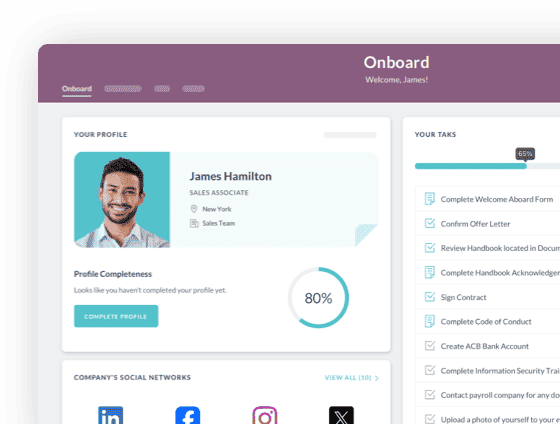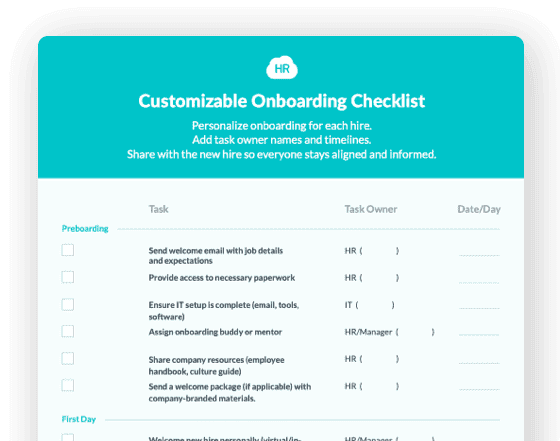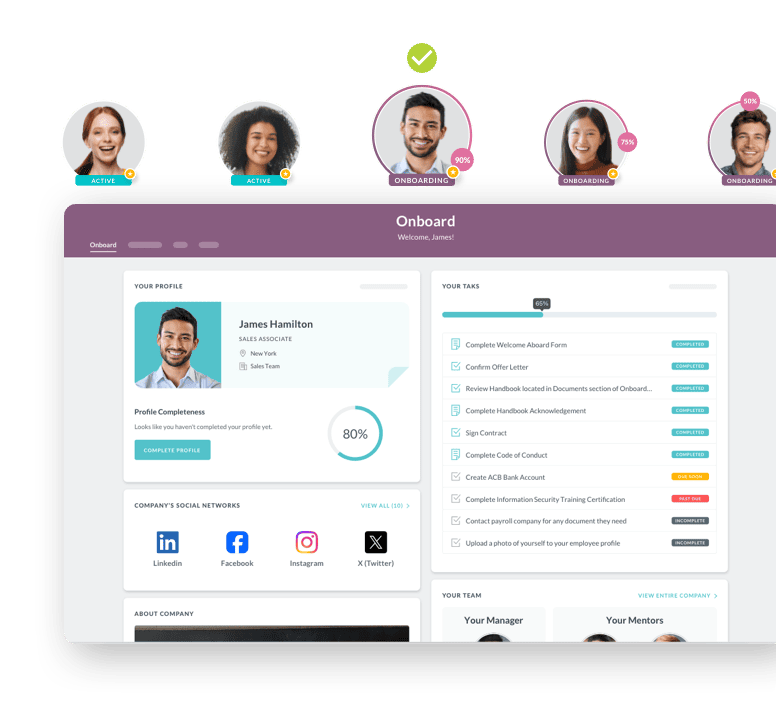Compliance Automation

 Cut onboarding time
by 60%—here's the
Ultimate Checklist
that helped do it.
Cut onboarding time
by 60%—here's the
Ultimate Checklist
that helped do it.

Compliance automation is more than just a software tool. It's a strategic way to use technology to manage legal, regulatory, and internal policy rules. Instead of relying on manual work, it uses software to handle tasks like data collection, report writing, and tracking changes in the law. For business leaders, this means spending less time on tedious paperwork and a lower chance of human error. It also provides a clear, up-to-the-minute view of the company’s compliance status. Using automation to follow the rules helps a business stay in good standing with the law while also improving its day-to-day work. This approach allows a company to grow and innovate without increasing its risk.
The Core Advantages of a Smarter System
Boosted Efficiency:
Automation cuts down on the time and work needed for compliance tasks. This lets your team focus on more important parts of their jobs, like serving clients or creating new products.
Higher Accuracy:
Automated systems make far fewer mistakes than people. This leads to more accurate forms and reports, which help your business avoid expensive fines and legal trouble.
Consistent Processes:
These systems follow the same rules and checks every single time. This ensures that your company's efforts to follow the rules are the same across all departments and teams.
Instant Clarity:
Leaders get a clear and instant view of all compliance tasks. This gives them a current understanding of the business's risk at all times.
Easy Growth:
As a company gets bigger, manual compliance work becomes much harder. Automated systems can easily handle a bigger workload without the need to hire more people. This allows a business to grow without adding more risk.
Comparing the Old Way to the New
|
Feature |
The Manual Way |
The Automated Way |
|
Process |
Requires people to manually collect documents and fill out forms. |
Uses software to collect data and fill out forms automatically. |
|
Speed and Efficiency |
Takes a lot of time and is often slowed down by human errors or lost papers. |
Very fast, with tasks completed in a short amount of time. |
|
Accuracy |
Prone to human errors, which can lead to fines and legal problems. |
Greatly reduces errors with pre-filled data and automatic checks. |
|
Visibility |
Status is often unclear or only available after a long review process. |
Provides a clear, up-to-the-minute view of all compliance tasks. |
|
Security |
Documents are at risk of being lost, stolen, or accessed by the wrong people. |
Data is stored securely in a compliant system with restricted access. |
|
Cost |
Costs are tied to staff time, training, and physical storage. |
Has initial setup costs, but then saves money on staff and materials over time. |
Making Automation Work for Your Business
Find the Right Fit for Your Business:
Don't just pick the first solution you see. Think about your company's size, industry, and the specific rules you need to follow. Choose a tool that can grow with your business and handle the types of compliance you need. Finding the right HR software for small businesses can be a great place to start this process.
Start With a Solid Plan:
Automation is not a magic fix. You must first have a clear process in place. Create a step-by-step guide for what needs to be done. Then, you can use software to automate those steps. This ensures everyone follows the same process and helps with onboarding best practices.
Invest in Training for Your Team:
People still need to know how to use the new tools. Spend time teaching your HR staff and managers how to use the automated system. This helps them understand why it is important and how to use it correctly. For more on this, you can look into a guide to innovative onboarding technology.
Protect Your Sensitive Data:
Automated systems handle a lot of private data. Make sure your solution has strong security to keep this information safe. Following rules like GDPR is very important. You can find more on this in a blog post about all eyes on GDPR.
Use Automated Alerts:
Set up your system to send alerts when things are due or when there are changes to rules. This makes sure no one misses a key task. For instance, when a worker has a new certification to get, an alert can be sent to both the worker and their manager. This can be key in managing a distributed workforce.


Common Missteps to Avoid
Treating It as a One-Time Task:
Compliance automation is not a “set it and forget it” solution. Rules change often. You must keep your system up to date with new laws. You also need to keep an eye on how it works. Forbes has written about how updating your compliance program is a key to long-term success.
Failing to Get Everyone on Board:
If your team does not trust or know how to use the new system, it will not work well. You need to get buy-in from all key people. This includes your finance, legal, and HR teams. They must see the benefits for themselves.
Working with Bad Data:
If the information you put into the system is wrong, the output will also be wrong. This is the "garbage in, garbage out" problem. Make sure your data is clean and correct before you start. The Harvard Business Review often talks about how vital good data is for any business process.
Not Maximizing Your Investment:
Many businesses use automation for simple things, like forms, but not for more complex tasks. A strong compliance system can do things like run reports, check for risks, and handle audits. You need to use its full potential. This is similar to a full HR technology suite that offers more than just one function.
Ignoring the Adverse Action Process:
If an automated background check flags a potential hire, you cannot just stop the process. You must follow the right steps to notify the person. Failure to do so can lead to legal issues. You can find more information on this process on the FTC website.
How Different Industries Benefit
Financial Services:
This industry has some of the strictest rules in the world. Compliance automation is a must here. Banks and other financial groups use it to check for fraud, handle client data, and make sure they follow rules like Sarbanes-Oxley. This helps them avoid huge fines and protects their clients.
Healthcare:
Patient privacy and data security are very important in this field. Healthcare groups use automation to follow laws like HIPAA. They use it to check that only the right people can see patient records and that all documents are handled with care. A culture of care is often a result of strong policies and systems that support workers.
Manufacturing:
In this field, rules often deal with worker safety, product quality, and the environment. Automation can help track that all safety checks are done on time and that all products meet the right standards. This helps keep workers safe and ensures high-quality products.
A Step-by-Step Guide to Implementation
Step 1:
Understand Your Current Process. First, write down how you handle compliance now. Find out what parts are slow, what has a lot of errors, and what is a pain for your team. This will help you know what to automate first.
Step 2:
Choose Your Platform. Based on your needs, find a software or platform that can help. Look for a system that can work with your other tools, like your payroll or HR system. For example, some tools, like electronic signature software, can easily be added to your current setup to make things faster.
Step 3:
Plan the Rollout. Start small. Pick one area, like new hire paperwork, to test the system. This gives your team a chance to learn the new tool without a lot of pressure. The U.S. Department of Labor has many resources on federal labor laws that can help you prioritize where to start your automation efforts.
Step 4:
Educate Your Team. Make sure everyone who will use the new system is well-trained. Give them clear guides and a place to ask questions. This helps with the change and makes sure the system is used the right way.
Step 5:
Review and Adjust. After you roll it out, watch how it works. Get feedback from your team. Find out what is working well and what is not. Make changes as needed. Keep in mind that a good onboarding process often relies on good automated systems.
What's Next for Compliance and Technology
The world of compliance automation is always changing. As new laws come out and technology gets better, the tools used to follow them also get better. One big trend is using AI to make things even smarter. For example, AI can be used to scan legal papers and tell you when a rule has changed. It can also help with things like making sure your new hire onboarding is in line with new laws.
Another trend is the move toward continuous monitoring. Instead of just checking on things once in a while, companies are now using tools that watch for problems all the time. This helps find issues before they become big problems. For instance, a system might notice a missing document and send an alert right away. It can also help with things like making sure every worker's data is safe. A strong guide to employee data protection is key in this new world of continuous monitoring. The World Economic Forum has written about how new tech is changing the way companies manage risk. As businesses become more global and rules become more complex, compliance automation will become even more important. It will move from being a nice-to-have tool to a must-have.
Keep Reading
AI for Frontline HR: Moving Beyond Sentiment Analysis to Build Tomorrow's Workforce Management Engine
TL;DR: While most organizations limit artificial intelligence in human resources to basic
Best HR Tools for Compliance Automation (and Why HR Cloud Leads the Pack)
The Compliance Catch-Up: What HR Needs to Fix Before Mid-Year Audits
By May, most HR teams have settled into the rhythm of the year. But compliance? That
Ready to streamline your onboarding process?
Book a demo today and see how HR Cloud can help you create an exceptional experience for your new employees.







